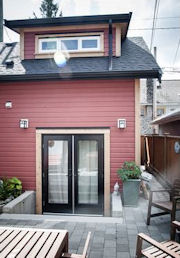by James A. Bacon
Cities across The United States and Canada are liberalizing their zoning codes to allow more “accessory units” like basement apartments, granny flats and even tiny houses in the back yard, reports the Wall Street Journal. The trend is especially evident in regions with housing shortages and high real estate prices like Vancouver, Seattle, San Jose and Washington, D.C.
In Vancouver, a cottage industry (so to speak) has grown up around building “laneway” houses, free-standing buildings under 750 square feet. Moreover, a third of the city’s new single-family homes now are built with a rental suite in the home, up from 5% in 2000.
Predictably, some neighbors are complaining. The accessory units contribute to overcrowding, they say. Renters will take up scarce parking space, add to traffic congestion, make more noise, block the sun in their backyards or otherwise reduce neighborhood real estate values.
Such complaints need to be addressed forthrightly because accessory units are an important part of the policy mix needed to create more compact, fiscally sustainable settlement patterns while avoiding housing shortages that price out the poor, the young and the elderly. From the perspective of a smart growth conservative, five points are worth making.
First, while accessory units may increase the population density of a neighborhood by today’s standards, they reverse a decades-long trend of de-densification. As the Journal notes:
Single-family neighborhoods have become less dense over the years—a function of an aging population and falling household sizes, says Robert Bruegmann, a professor emeritus of architecture and urban planning at the University of Illinois at Chicago. As children leave for college and jobs, many seniors find themselves in homes too big for their needs. The generation behind them, meantime, continues to have fewer children—reducing its need for space
In other words, increasing numbers of accessory units allow urban neighborhoods to return to population densities for which they were originally designed. Why would cities support regulations to halt a healthy evolution?
Second, allowing homeowners to convert idle space (in the case of basement and garage apartments) or add new space (in the case of laneway houses) creates a revenue stream from the property. That revenue stream should increase the property owner’s ability to maintain the property — a real consideration for elderly families on fixed incomes. Better-maintained houses and yards lift property values for neighbors, too.
Third, accessory units provide an alternative to institutionalizing the elderly in extended living facilities and nursing homes. When Grandpa and Grandma live semi-independently in their flat out back, they can watch the kids after school, and family members in turn can look out for them. Anyone who supports strong families should embrace this arrangement.
Fourth, there is a question of property rights. Conservatives believe in an expanded definition of property rights. As long as accessory units don’t interfere with the public health or safety, and as long as they don’t pose a nuisance to neighbors, property owners should be allowed to do what they please on their own property.
Fifth, accessory units are fiscally efficient. They embed new housing in an existing urban fabric of streets, sidewalks, water, sewer and utilities. They pose no added cost to public services. And given the fact that most such units are occupied by individuals, not families with school-aged children, they don’t even burden local schools. Best of all, they create affordable housing without public subsidies. Conservatives should celebrate free-market policy alternatives to affordable housing.



